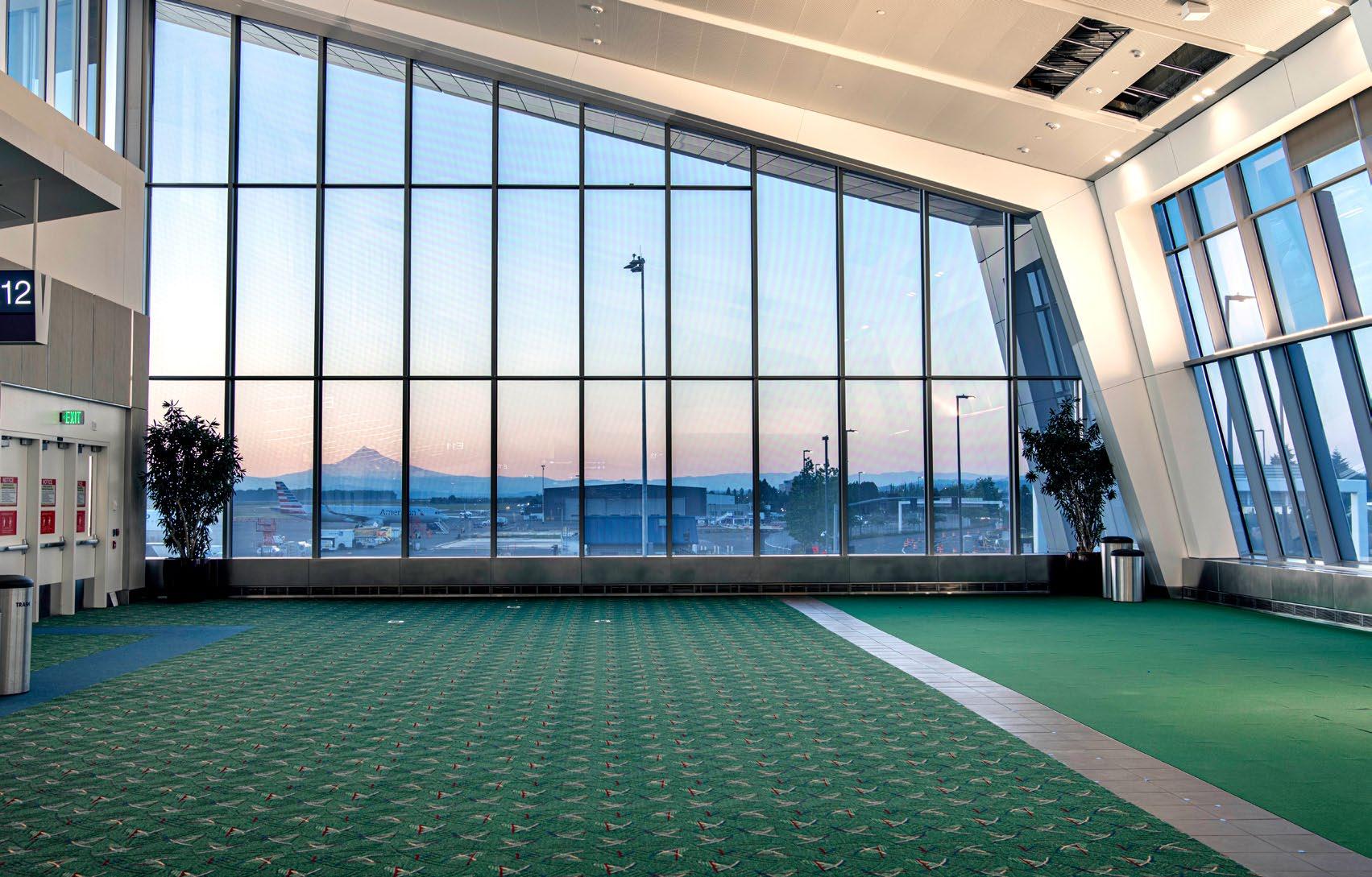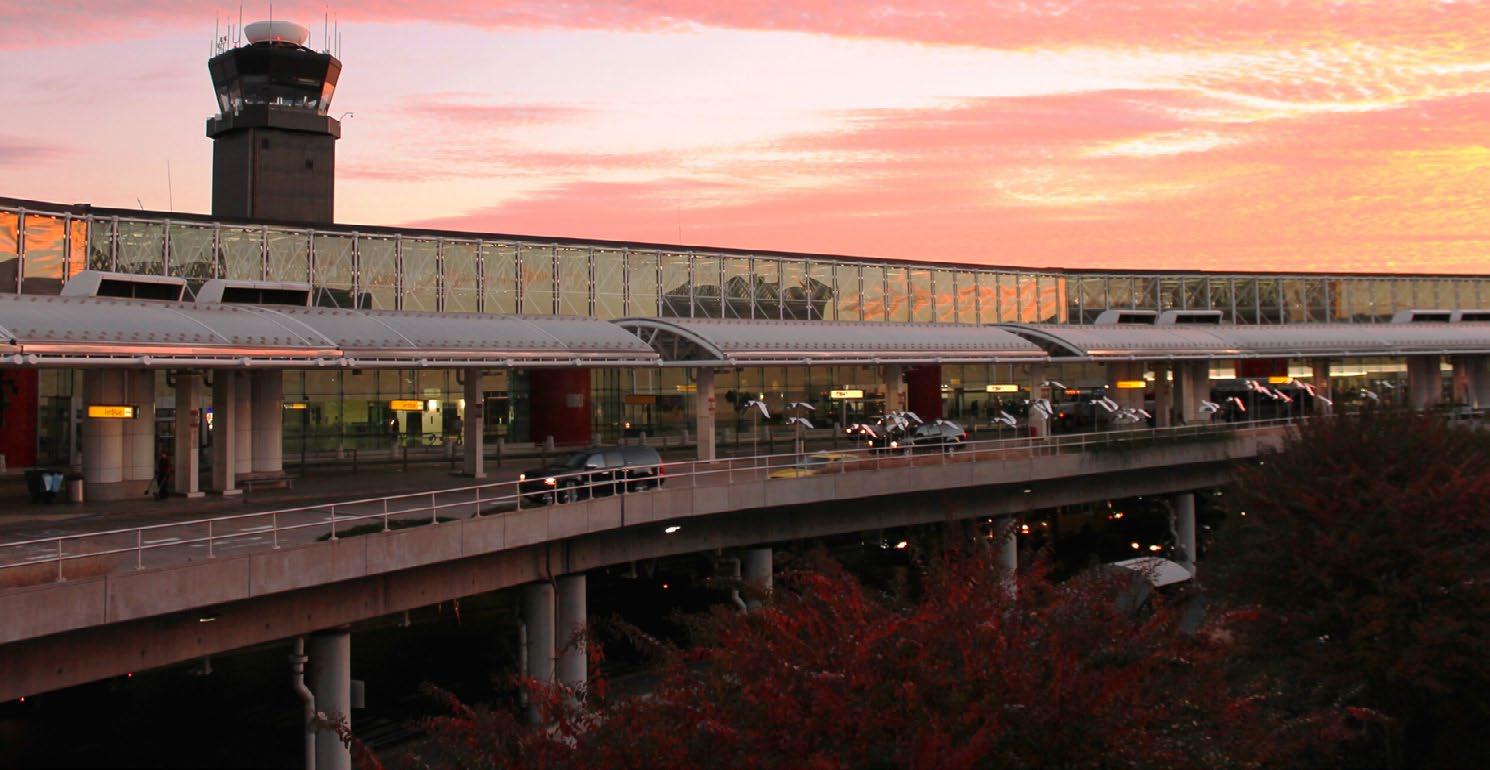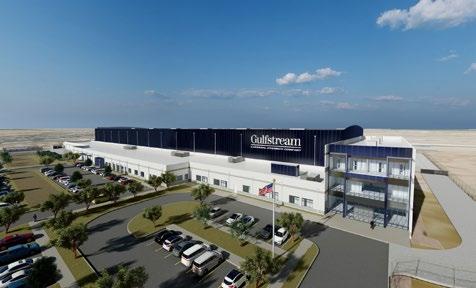
9 minute read
Airports Back in Business in a Big Way
BY DAVID HODES
Funding new development on a blistering pace to help prop up the airport industry comeback
It’s been a rough few years for airport industry operations. “When you see the losses in 2020 and 2021—and indeed, this year—where we are still expecting losses on the order of $10 billion, the industry will have lost around $190 billion in the three years since this pandemic started,” said Willie Walsh, the director general of the International Air Transport Association (IATA), speaking in September at a media briefing. “But if you go back.. between 2010 and 2019, I think that was the first time that the industry had made profits at an operating level, consecutively. And these were the best 10 years of the industry’s history. And interestingly, the average margin over that period was five wand a half percent.
“You compare that to the margins over the last three years, such as minus 29 percent and minus 1.8 percent expected this year, these have been so very, very tough times,” he said.
A Big Shot in the Arm
Yes indeed, that prediction looks to be true because the U.S. airport industry just got a huge shot in the arm.
One of the biggest bits of positive news in airport development was the Biden-Harris Administration announcement in February that nearly $1 billion from the new Bipartisan Infrastructure Law will be dedicated to airport funding.
Signed into law November 15, 2021, the Bipartisan Infrastructure Law is the largest long-term investment in our infrastructure and economy in the country’s history. It provides $550 billion over fiscal years 2022 through 2026 in new federal investment in infrastructure, including in roads, bridges, and mass transit, water infrastructure, and broadband.
The Federal Aviation Administration (FAA) is awarding that $1 billion from Biden’s infrastructure law through grants to 99 airports of all shapes and sizes across the country.
Grants Breakdown
Many grants are earmarked for new or expanded terminal facilities. Among them are:

• $10.8 million to Des Moines International Airport in Des Moines, Iowa. This project replaces the 1948 terminal that is beyond its useful life and operating above capacity. Recent data shows aeronautical demand at 109 percent of pre-pandemic levels. This project offers opportunities to strengthen climate resilience and create good paying jobs. This phase includes the preparation and construction of the terminal foundation.
• - $29 million to Salt Lake City International Airport (SLC) in Salt Lake City, Utah. The New SLC is a phased terminal and north concourse redevelopment program which replaces aging and capacity-constrained facilities.
Many grants contain an element that will improve passenger experience, including more reliable and faster baggage systems. Among them are:
• $4.4 million to Ted Stevens Anchorage International Airport in Anchorage, Alaska. The project increases north terminal capacity by installing common use equipment and upgrading the baggage handling system.
• $4.3 million to Lawton-Fort Sill Regional Airport in Lawton, Oklahoma. The terminal modernization and expansion project includes a building expansion with a new baggage claim and meeter-greeter areas, a new and expanded security checkpoint, and a hold room expansion that accommodates two airline gates. This award will provide funding to complete the final phase of the project, which includes an expanded airline counter, office spaces, conveyor baggage handling system for departures, a passenger boarding bridge and curbside area updates that will help provide a smoother experience for travelers getting in and out of the airport.
• $38 million to Baltimore/Washington International Thurgood Marshall Airport in Baltimore, Maryland. This project will fund a portion of the concourse A and B expansion project to include baggage system improvements, direct airside connection between concourses A and B, expanded apron level operations space, larger hold rooms, new concession space and modern restrooms.
Other grants are geared to increase terminal sustainability. Among them are:
• $6 million to Portland International Airport in Portland, Oregon. This project will convert the heating system at the terminal from boilers fueled by fossil fuels to an electric-powered heat pump. This project will significantly improve energy efficiency, reduce greenhouse gas emissions and harmful pollutants, create job opportunities and strengthen climate resilience for the facility.
• $15 million to Philadelphia International Airport in Philadelphia, Pennsylvania. This project funds a portion of the terminal energy optimization program. This will replace and upgrade pre-condition air (PCA) units and ground power units (GPUs) at 25 gates. This equipment powers and cools aircraft while at the gate, avoiding the use of aircraft engines. The airport is also receiving a second grant of $15 million to improve accessibility in the terminal. That grant will fund the renovation and construction of terminal restrooms, adult assisted care, mother’s rooms and service animal relief areas.
• $35 million to Dallas-Fort Worth International Airport (DFW) in Texas. This award funds the second phase of the installation of the airport’s zero carbon electric central utility plant (eCUP), which will be powered 100 percent by renewable energy. The eCUP will position DFW to achieve its target of net-zero carbon emissions by 2030, providing the airport with uninterrupted, redundant service. The grant also funds a portion of the terminal D energy efficiency enhancement program that replaces aging infrastructure with modern systems to significantly improve energy efficiency and reduce emissions.
And Even More Funding News
In September, New York Governor Kathy Hochul announced $230 million in awards to nine upstate airports for revitalization projects that reimagine and further modernize airports across upstate New York.
This funding comes from the Upstate Airport Economic Development and Revitalization Competition, a competitive solicitation which aims to promote, revitalize and accelerate investments in upstate commercial passenger service airports.
According to a press release, funded activities include the planning, design and construction of state-of-the-art boarding concourse and concession areas; terminal expansion or rehabilitation; improved security screening; opportunities to move passengers more safely and efficiently with improved distancing during and after the pandemic; new innovations in contactless technology and an increased focus on cleanliness and disinfection.
KC Eye-Popping Upgrade
One of the longest anticipated airport redevelopments is the new Kansas City International Airport (KCI), a $1.5 billion redo of the 1972-era three-terminal airport located on the same property 20 miles north of downtown Kansas City. The revised KCI opened ahead of schedule on February 28.
The new main terminal is the largest single infrastructure project in the city’s history. Design and construction efforts began in 2018, and the project broke ground in March, 2019. The new terminal is a million square feet, with 40 gates and plans to expand to 50, featuring nearly 50 local and national food, beverage, and shopping experiences.
Two moving walkways help transfers between two concourses, and consolidated and flexible security checkpoints with 16 lanes were designed to accommodate the flow of passenger volume. There is also a new 6,200-space garage adjacent to the terminal, and two levels in the terminal—one for departures and one for arrivals, with clear wayfinding and sightlines.

Airport’s New Design Elements
KCI illustrates many of the new ideas in airport design, such as biophilic design, or the connecting of people with nature by incorporating natural elements such as plants, water features, and natural light into the design of the terminal; user experience design focusing on creating a positive and stress-free experience for passengers by improving wayfinding, creating comfortable seating areas, and optimizing security screening processes; and technology integration, such as airport terminals integrating self-check-in kiosks, biometric screening, and mobile apps to streamline the passenger experience and reduce wait times.
Probably one of the bigger ideas being incorporated by airport developers is a flexible design to adapt to changing needs and circumstances, such as shifting passenger volumes, new security requirements, or changes in airline operations—much of which was learned from the disruptive changes of the pandemic.
The Path to Ongoing Development
The path to global airport development is clearer and more open now as the pandemic subsides, and it’s going full tilt.
For example, it was the pandemic that nearly completely shut down the Istanbul’s airport in 2018. Now it’s up to its full capacity of 200 million passengers per year.
The $18 billion Beijing Daxing International Airport, currently the biggest in the world, opened in 2019 and has a capacity of up to 100 million passengers per year. It is designed to be one of the world’s most technologically advanced airports.

Dubai’s Al Maktoum International Airport is being developed to
North Carolina Airport Embraces Aerospace Innovation
Aerospace innovators have discovered that there is a place for them in central North Carolina at the Piedmont Triad International Airport, where airport and government leaders have laid out a welcome mat for fresh thinking and new ideas.
“We want our airport to become known as the place where big ideas in aerospace come to be proven and to be launched,” says Kevin Baker, PTI’s executive director. “We want to lead, not follow.”
The latest entry into the airport’s stable of innovators is Boom Supersonic, the ambitious project that promises to put supersonic passenger jets back into service by 2029, with an affordable ticket price and a zero-carbon footprint.
Boom broke ground in January on its first manufacturing plant, which will be located on 62 acres on the PTI campus. The manufacturing facility will include a final assembly line and various support buildings. The first production aircraft, called Overture, is expected to make its debut in 2026 with the production of the final product to begin at PTI in 2029.
“Building on our legacy of ‘First in Flight,’ North Carolina is ready to partner with Boom Supersonic in leading the way to a fast and clean aviation future,” Gov. Roy Cooper said at the January groundbreaking.
The company expects to employ 2,400 people by 2032 in the 174,000-square-foot facility. The company already has orders for 130 aircraft from companies such as American Airlines, United Airlines, and Japan Airlines. Boom is also working on government and defense applications for the supersonic airliner.
Boom is not the first time the airport has nurtured innovation. Honda pioneered a radical new design at PTI for an ultralight business aircraft with engines mounted over the wings rather than underneath. That jet, the HondaJet, is now a reality and one of the bestselling of its type.
The Honda Aircraft Company was born and ultimately decided to locate its world headquarters at the airport, complete with administrative offices, a manufacturing plant, and maintenance and repair facilities. Honda also manufactures engines for the HondaJet a short distance away in Burlington, NC.
With a central East Coast location, proximity to a network of Interstate highways, and nearly 1,000 acres ready for industrial development, the airport has proven attractive to all aspects of the aerospace industry –manufacturing, cargo, and maintenance and repair and overhaul (MRO).
FedEx has a Mid-Atlantic hub located at the airport, HAECO Americas, one of the world’s largest MRO organizations, has its North American Headquarters at the airport and Cessna/Textron operates its busy midAtlantic maintenance facility at the airport.
“There are currently more than 10 proposed new projects considering the airport,” Baker said. “Not all will come to fruition, but the fact that so many companies are showing interest in locating manufacturing operations here demonstrates the fact that the industry sees PTI, the region, and the state as a prime place to call home.”
Altogether, about 50 companies are located on airport property and taken altogether employ nearly 9,000 people. A supply-chain network of nearly 200 aerospace companies have located in the Piedmont Triad region near the airport providing even more aerospace jobs.
Thanks to the vision of past airport leadership, there is room for more companies to locate at PTI. The airport has assembled a 1,000-acre, aerospace “mega site” to accommodate a new wave of growth. Much of that land has been graded, has Interstate and runway access, and is ready for new development.
“Vision and foresight are part of this airport’s DNA,” Baker said. “We’re standing on the shoulders of those who came before us and laid the groundwork for this to happen.”
Airport Development Insight Industry

become the next world’s largest airport, with an expected capacity of up to 220 million passengers per year. The first of two phases of development is expected to be completed by 2030.
What’s Next?
A combined McKinsey and International Air Transport Association (IATA) report released in December, 2022, found that airports were broadly more resilient than airlines during the pandemic.
Airports faced drops in aeronautical revenues and passenger-related retail and services. Unsurprisingly, given the depth of the crisis, many airports both needed and received government support through the course of the pandemic, according to the report, which “combined with continued inflows from real estate and other sources, lessened the impact of the crisis.”
There is an opportunity today for greater sharing of data and insights across the value chain, the report found. “This could include enhance data sharing between airlines, airports, and handlers about expected volumes—leading to better short-term projections and enhanced operational planning at airports.” X










